Trajan tasked his architect with moving an entire hill to make room for this extravagant public space.
Apollodorus of Damascus, The Forum of Trajan, dedicated 112 C.E., Rome
Apollodorus of Damascus, The Markets of Trajan, 112 C.E., Rome
An emperor worth celebrating
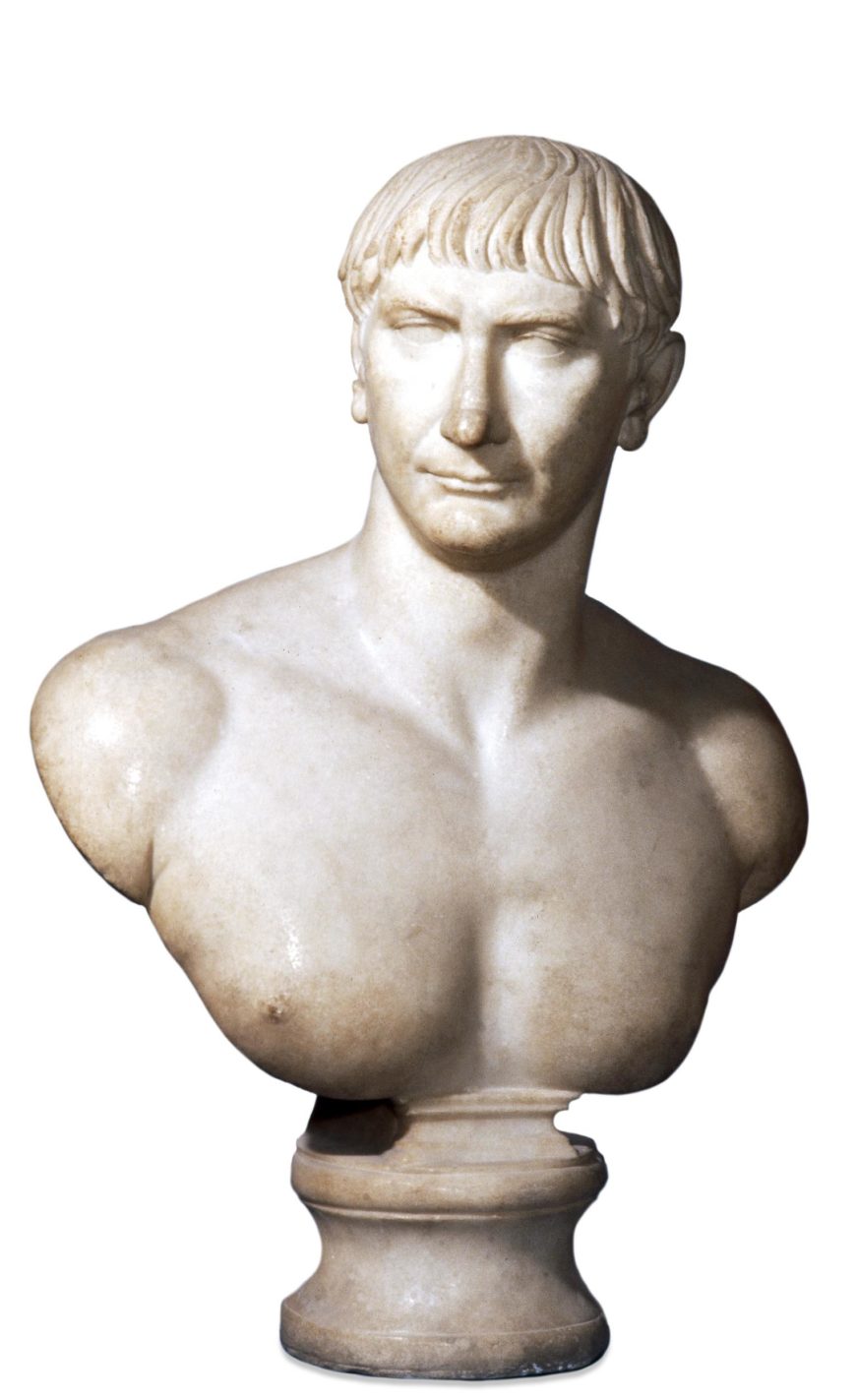
Marble bust of Trajan, c. 108–117 C.E., 68.5 cm high (© Trustees of the British Museum)
Marcus Ulpius Traianus, now commonly referred to as Trajan, reigned as Rome’s emperor from 98 until 117 C.E. A military man, Trajan was born of mixed stock—part Italic, part Hispanic—into the gens Ulpia (the Ulpian family) in the Roman province of Hispania Baetica (modern Spain) and enjoyed a career that catapulted him to the heights of popularity, earning him an enduring reputation as a “good emperor.”
Trajan was the first in a line of adoptive emperors that concluded with Marcus Aurelius. These emperors were chosen for the “job” based not on bloodlines, but on their suitability for rule; most of them were raised with this role in mind from their youth. This period is often regarded as the height of the Roman empire’s prosperity and stability. The ancient Romans were so fond of Trajan that they officially bestowed upon him the epithetical title optimus princeps or “the best first-citizen.” It is safe to say that the Romans felt Trajan was well worth celebrating—and celebrate him they did. A massive architectural complex—referred to as the Forum of Trajan (Latin: Forum Traiani or, less commonly, Forum Ulpium) was devoted to Trajan’s career and, in particular, his great military successes in his wars against Dacia (now Romania).
Unique under the heavens
The Forum of Trajan was the final, and largest, of Rome’s complex of so-called “Imperial fora”—dubbed by at least one ancient writer as “a construction unique under the heavens” (Amm. Marc. 16.10.15). Fora is the Latin plural of forum—meaning a public, urban square for civic and ritual business. A series of Imperial fora, beginning with Iulius Caesar, had been built adjacent to the earlier Roman Forum by a series of emperors. The Forum of Trajan was inaugurated in 112 C.E., although construction may not have been complete, and was designed by the famed architect Apollodorus of Damascus.
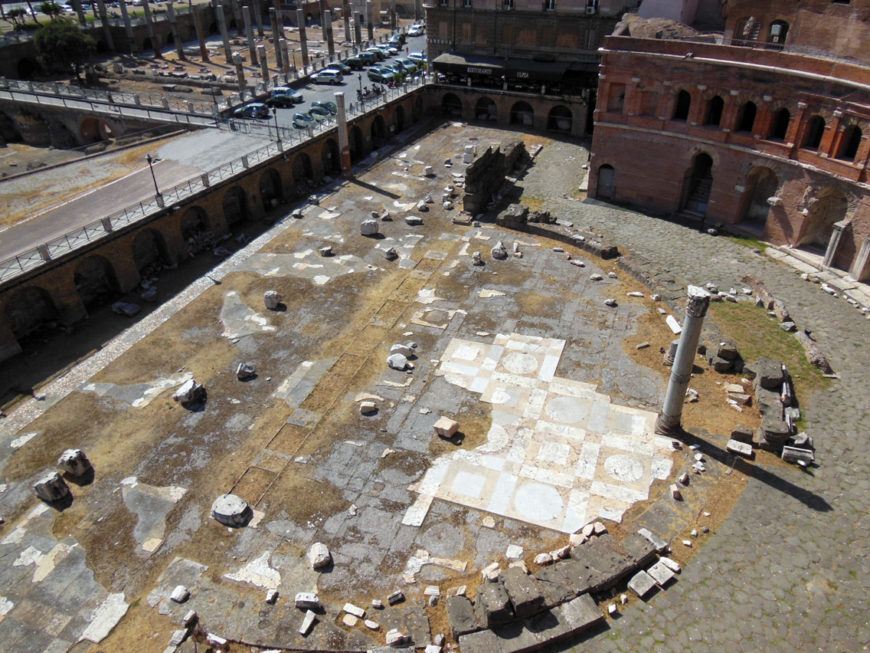
View from the Markets of Trajan of the remains of the eastern exedra and the eastern portico of the main square of the Forum of Trajan, looking toward the Basilica Ulpia (in the upper left) (photo: MM, CC BY-SA 3.0)
The Forum of Trajan is elegant—it is rife with signs of top-level architecture and decoration. All of the structures, save the two libraries (which were built of brick), were built of stone. There is a great deal of exotic, imported marble and many statues, including gilded examples. The forum was composed of a main square (measuring c. 200 x 120 meters) that was flanked by porticoes (an extended, roofed colonnade), as well as by exedrae (semicircular, recessed spaces) on the eastern (above) and western sides.
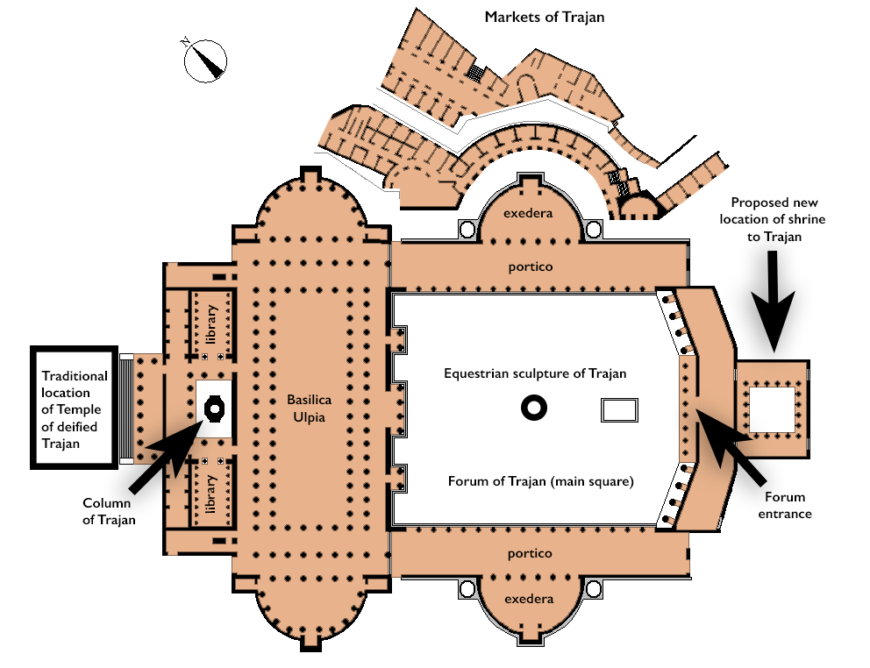
Plan of the Forum of Trajan. Note that the traditional site of the temple of the deified Trajan is shown, but is replaced by a shrine located at the southern side of the forum’s main square (following R. Meneghini) (image: Slånbär, CC BY-SA 3.0, annotated by Smarthistory)
A contested element of the reconstruction of the forum complex is a temple dedicated to the deified Trajan (the deceased emperor had been declared a god). Traditional reconstructions place this temple behind the column, although a recent reconstruction favored by Dr. Roberto Meneghini does not agree with this conjecture, instead preferring to place a shrine to the deified Trajan at the southern end of the forum abutting the retaining wall of the neighboring Forum of Augustus. Scholars continue to debate the nature and position of this temple.
The main structure at the center of the forum complex is the massive Basilica Ulpia, and beside that stood two libraries that flanked the Column of Trajan, an honorific monument bearing an elaborate program of sculpted relief.
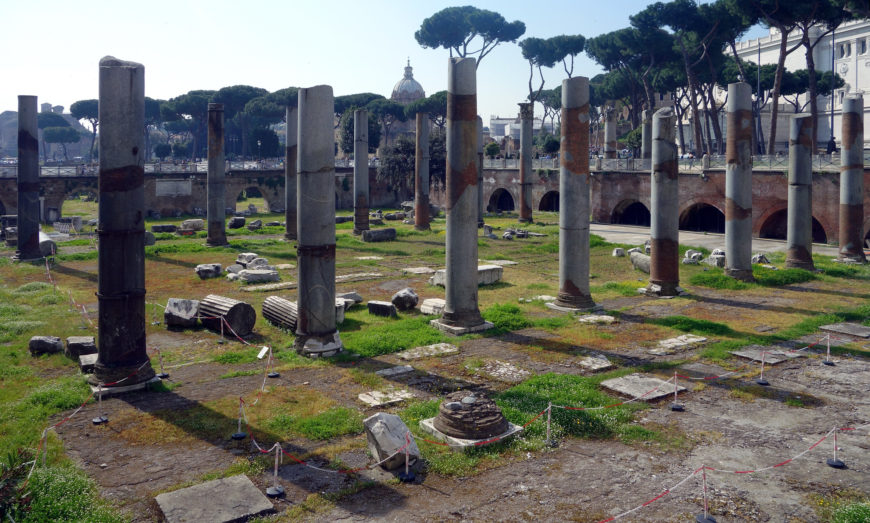
Remains of the Basilica Ulpia (photo: Steven Zucker, CC BY-NC-SA 2.0)
Paved in white marble: The forum square (Area Fori)
The main square of the forum was once a vast space, screened by architecture on all sides and paved in white marble. Several rows of trees, and perhaps rows of statues, ran parallel to the porticoes. Entry to the forum square was from the south, by way of a triumphal arch surmounted by a statue of Trajan riding in a triumphal chariot. Although the arch itself is no longer extant, it is depicted on a coin issued c. 112–115 C.E. (below).
![Gold coin (aureus) struck at Rome c. 112–115 C.E. (19 mm, 7.13 g, 7h). The legend reads “IMP TRAIANO AVG GER DAC P M TR P COS VI P P (“To the emperor Trajan Augustus Germanicus Dacicus, Pontifex Maximus, [holder of] tribunician power, in his sixth consulship, father of his country.” The coins depicts a laureate Trajan (draped, and cuirassed bust right) seen from behind on the observe side. On the reverse the Arcus Traiani of the Forum of Trajan is seen. This is presented as a hexastyle building facade, crowned by a frontal chariot drawn by six horses. Three figures stand to the left and right, while four statues occupy niches in the arches below. The reverse legend reads “FORVM TRAIAN[A]” (image)](https://smarthistory.org/wp-content/uploads/2022/01/TrajansForumCoins.jpeg)
Gold coin (aureus) struck at Rome c. 112–115 C.E. (19 mm, 7.13 g, 7h). The legend reads “IMP TRAIANO AVG GER DAC P M TR P COS VI P P (“To the emperor Trajan Augustus Germanicus Dacicus, Pontifex Maximus, [holder of] tribunician power, in his sixth consulship, father of his country.” The coins depicts a laureate Trajan (draped, and cuirassed bust right) seen from behind on the observe side. On the reverse the Arcus Traiani of the Forum of Trajan is seen. This is presented as a hexastyle building facade, crowned by a frontal chariot drawn by six horses. Three figures stand to the left and right, while four statues occupy niches in the arches below. The reverse legend reads “FORVM TRAIAN[A]” (image)
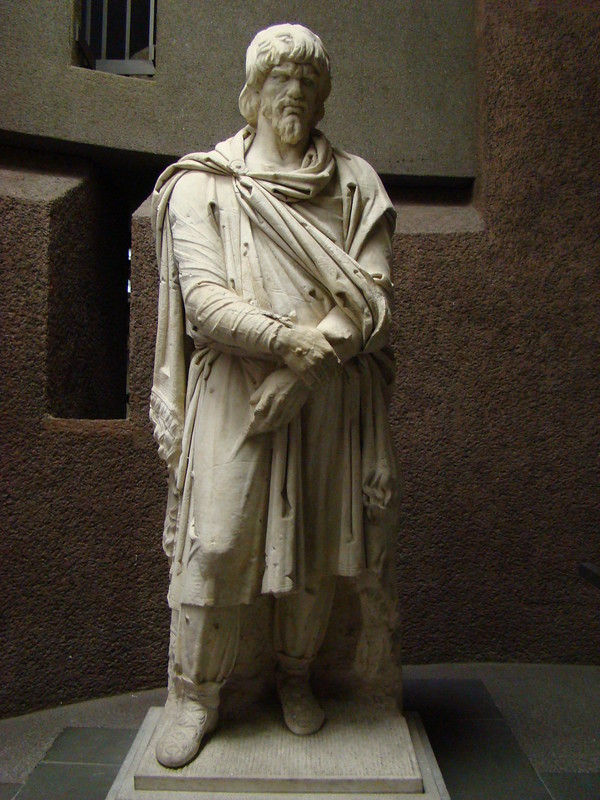
Captured Dacian, 106–112 (Vatican Museum; photo: F. Tronchin, CC BY-NC-ND 2.0)
The forum square (116 x 95 meters) has an overriding martial theme, reminding viewers and visitors that the forum was constructed from the proceeds (manubiae) of Trajan’s successful military campaigns against the Dacians (101–102, 105–106 C.E.). The porticoes were decorated with statuary and military standards (official emblems of the legions), as described by the ancient author Aulus Gellius: “All along the roof of the colonnades of the forum of Trajan gilded statues of horses and representations of military standards are placed, and underneath is written Ex manubiis [from the spoils of war] …” (Attic Nights 13.25.1).
The decorative program also included statues of captured Dacian prisoners (left) and, it seems, statues of notable Roman statesmen and generals that were set in the intercolumnar spaces of the porticoes.
At the center of the Forum square stood a bronze equestrian statue of Trajan, the Equus Traiani. While the statue itself does not survive, the occasion of a visit to Rome by Constantius II (in 357 C.E.) preserves a mention of the famous equestrian: “So he [Constantius II] abandoned all hope of attempting anything like it, and declared that he would and could imitate simply Trajan’s horse, which stands in the middle of the court with the emperor on its back.” (Ammianus Marcellinus 16.10.15) We also see the equestrian statue depicted on a silver denarius struck at Rome c. 112–114/5 C.E. (below).
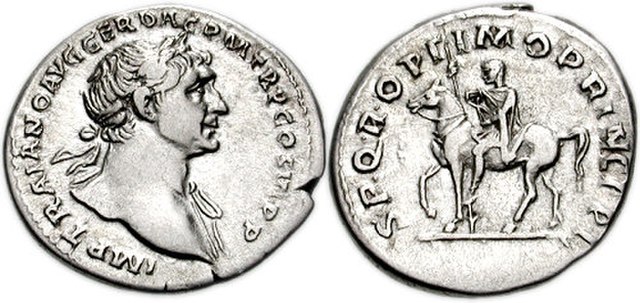
Silver coin, Denarius (19mm, 3.35 g, 7h), struck 112–114/115 C.E IMP TRAIANO AVG GER DAC P M TR P COS VI P P, laureate bust right, drapery on far shoulder S P Q R OPTIMO PRINCIPI, equestrian statue of Trajan facing left, holding spear and sword (or small Victory) (image: Cristiano64, CC BY-SA 2.5)
The massive Basilica Ulpia
As an architectural type, the basilica is uniquely Roman and served various civic and juridical purposes. The habit of planners from the first century B.C.E. onwards had been to prefer to use the basilica as a framing device, so as to have it communicate with the flanks of a forum square. We see this in many cases, although with some variation. In the case of the Forum of Trajan the massive and monumental Basilica Ulpia is constructed at the northern edge of the open courtyard. It thus serves to bisect the complex, with the portico-lined courtyard lying to its east and the libraries and the Column of Trajan to its west.
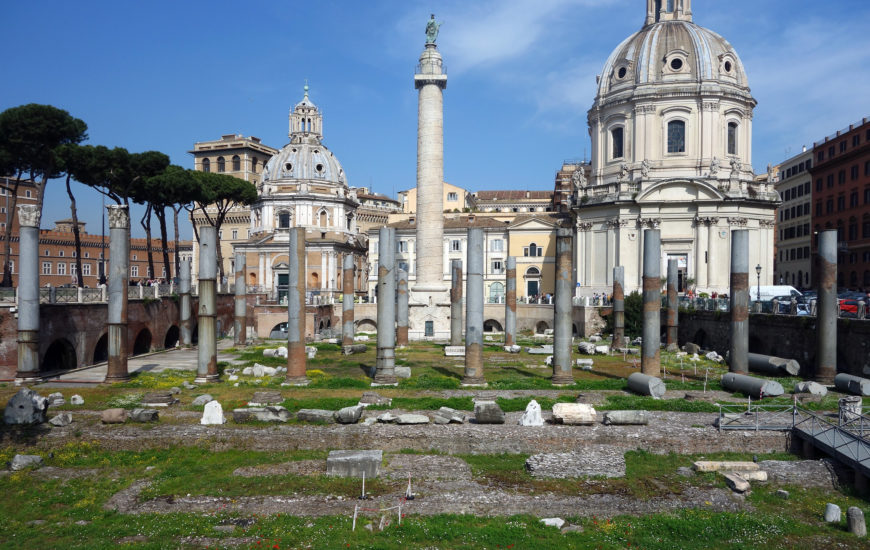
Remains of the Basilica Ulpia in the foreground, and the Column of Trajan in the middle ground (photo: Steven Zucker, CC BY-NC-SA 2.0)
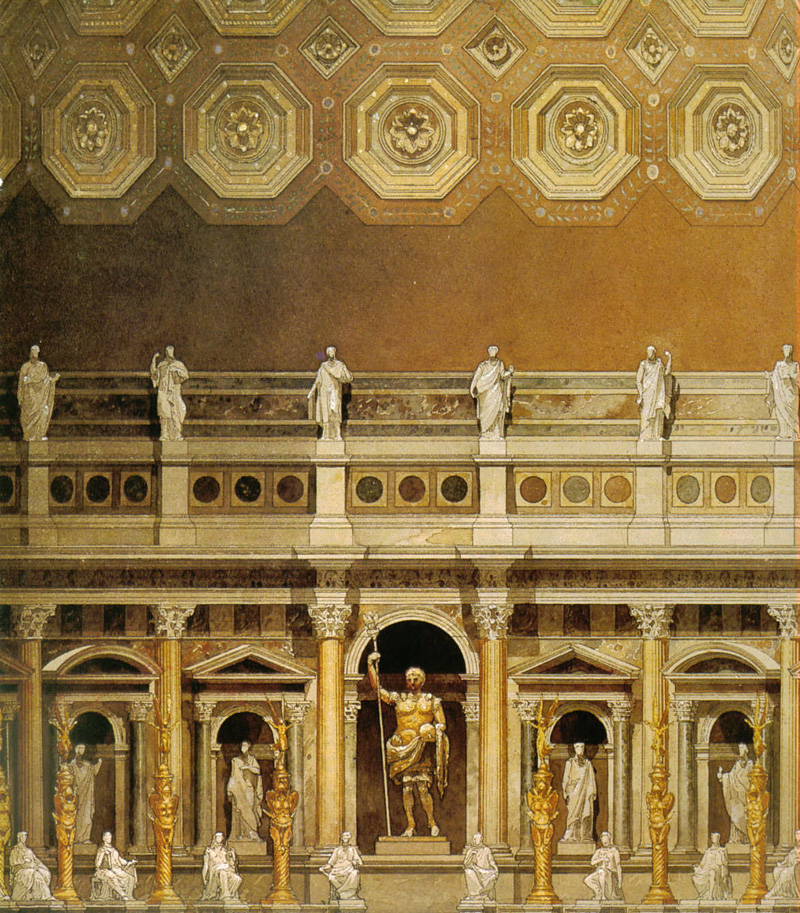
Artist’s view of exterior elevation (J. Gaudet, 1867; image: Joris)
The basilica is massive—its overall length is some 169 meters and the interior nave is 25 meters wide. It is apsidal at both ends, with a raised central floor, and the main hall has a double surround of columns (96 in total) that were probably of white or yellow marble, in the Corinthian order. The basilica was also famous in antiquity for its gilded bronze roof tiles, as commented on by Pausanias, who remarked that the building was “worth seeing not only for its general beauty but especially for its roof made of bronze” (Description of Greece 5.12.6).
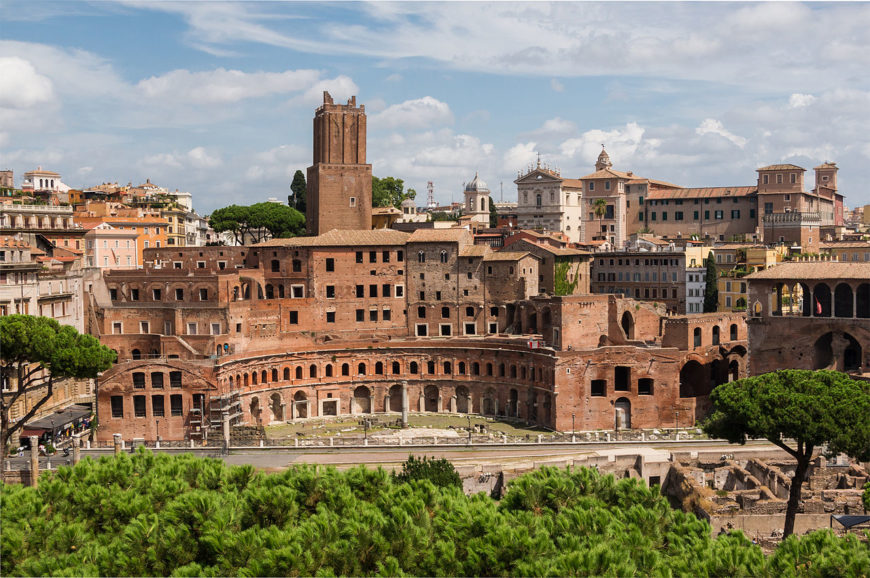
Apollodorus of Damascus, The Markets of Trajan, 112 C.E. the Militia Tower is visible in the center, rising above the markets (photo: Jebulon, CC0 1.0)
The Markets of Trajan (dedicated c. 110 C.E.)
Adjacent to the Forum of Trajan is a separate architectural complex attributed to Trajan that is commonly referred to as the Markets of Trajan. This multi-level commercial complex was built against the flank of the Quirinal Hill which had to be excavated for the purpose. The complex of the markets takes its planning cue from the eastern hemicycle of the Forum of Trajan. The ruins of the markets today preserve 170 rooms and the complex covers a space of approximately 110 by 150 meters; its walls stood to 35 meters above the level of the pavement of the Forum of Trajan. The original extension is hard to ascertain, based in part upon subsequent re-use and construction in the Medieval period (and later). The archaeologist Corrado Ricci (1858–1934) cleared the ruins in the twentieth century, but the markets themselves have received comparatively less attention than the adjacent forum.
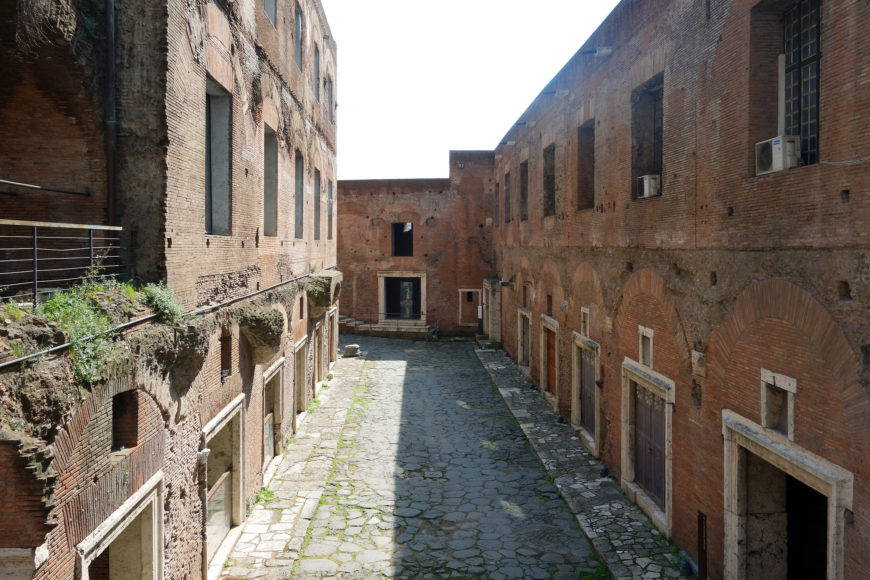
Apollodorus of Damascus, The Markets of Trajan, 112 C.E. (photo: Steven Zucker, CC BY-NC-SA 2.0)
The function of the markets was mercantile—indeed the markets may have been designed to relocate shops (tabernae) and offices that were displaced by the Trajanic building project. The ground floor offices (at the forum level) were likely occupied by cashiers of the imperial treasury (arcarii caesariani), while upper level rooms may been leased out or used by imperial officials associated with the grain dole (annona).
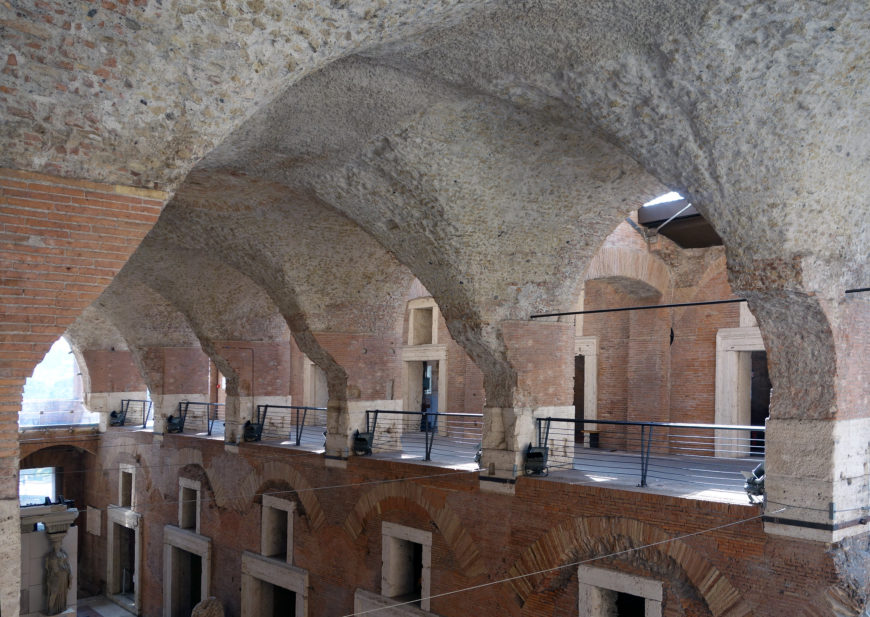
Apollodorus of Damascus, The Markets of Trajan (Market Hall), 112 C.E. (photo: Steven Zucker, CC BY-NC-SA 2.0)
The great, vaulted market hall (above) is an ambitious and brilliant design—just as with the rest of the complex, reflecting the skills of the designer / architect who executed the project. The medieval Militia Tower (Torre delle Milizie) (12th century) and the now-demolished convent of Santa Caterina a Magnanapoli utilized portions of the structure of the market’s buildings.
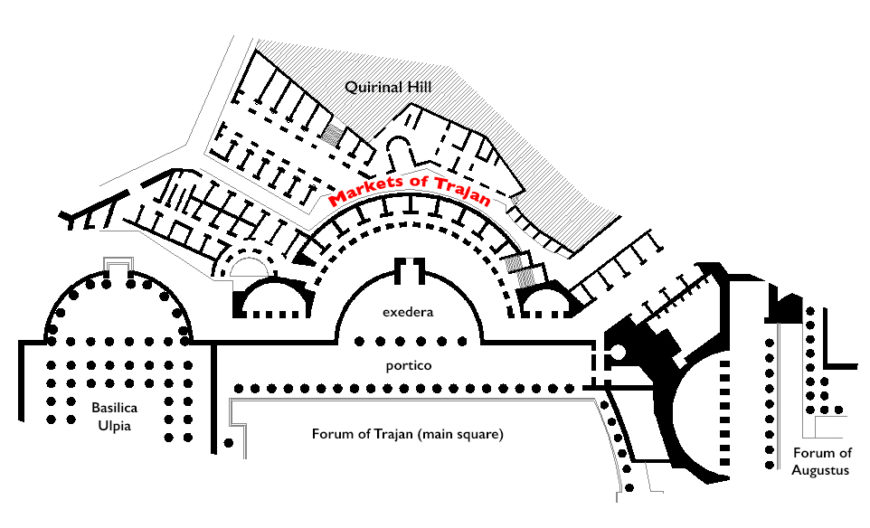
Plan of the Markets of Trajan (in relation to the Forum of Trajan) (image: 3coma14; annotated by Smarthistory)
The architect—Apollodorus of Damascus
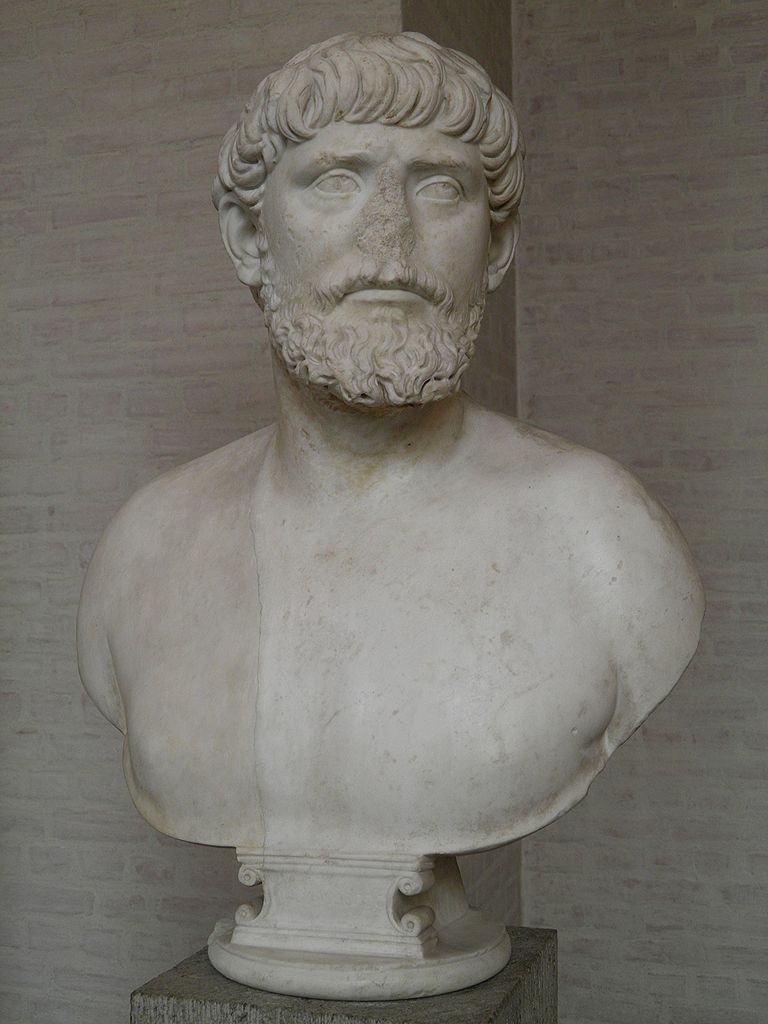
Portrait considered to be that of Apollodorus of Damascus (Munich Glyptothek; photo: Butko, CC BY-SA 2.0)
Apollodorus of Damascus was a military engineer and architect who was active during the first quarter of the second century C.E. He accompanied the emperor Trajan on his campaigns in Dacia and is famous for building a bridge across the Danube river that was both described by ancient authors and depicted in art. The relief from the Column of Trajan depicts the bridge in the background (see below). Built c. 105 C.E., the segmental arch bridge was the first across the lower Danube and allowed Roman soldiers to cross the river easily. Apollodorus, who is described as “the master-builder of the whole work” is credited with the project (Procopius, Buildings, 4.6.11–14; tr. H.B. Dewing). Upon return from the Dacian Wars, Apollodorus is thought to have been the architect behind the project that produced the Forum and Column of Trajan, as well as the adjacent markets. A textual tradition is preserved by Cassius Dio that has Apollodorus running afoul of (and being executed by) Hadrian, Trajan’s successor, although it is unclear whether credence should be given to this story (Cassius Dio, Roman History, 69.4; tr. Cary).

Relief from the Column of Trajan, Carrara marble, completed 113 C.E., showing the bridge in the background and in the foreground Trajan is shown sacrificing by the Danube river (photo: Gun Powder Ma)
Significance of the “construction unique under the heavens”
The Forum of Trajan earned a great deal of praise in antiquity—and it has been the focus of scholarly study perhaps since 1536 when Pope Paul III ordered the first clearing of the area around the base of the Column of Trajan. Paul III would then protect the column itself in 1546 by appointing a caretaker to look after it. The seventeenth and eighteenth centuries saw various artists and architects produce renderings and plans of the forum and its monuments. Among the most famous of these are those of Dosio (c. 1569) and Etiénne Du Pérac (1575). In terms of public architecture in Imperial Rome, the Forum of Trajan complex is a crowning achievement in its vast monumentality. The execution of its sophisticated and elegant design surpassed all of its predecessors in the complex of forum spaces in the city. The value of vast public spaces in the city of Rome cannot be underestimated. For the average city dwellers accustomed to narrow, dim, crowded streets the soaring, the gleaming open space of the forum, bounded by elaborate architecture and sculpture, would have had a powerful psychological effect. The fact that the monuments glorified a revered leader also served to create and reinforce important ideological messages among the Romans. Overall the role of public architecture in the Roman city, and the Roman consciousness, is an important reminder of the ways in which Romans used built space to establish and perpetuate messages about identity and ideology.
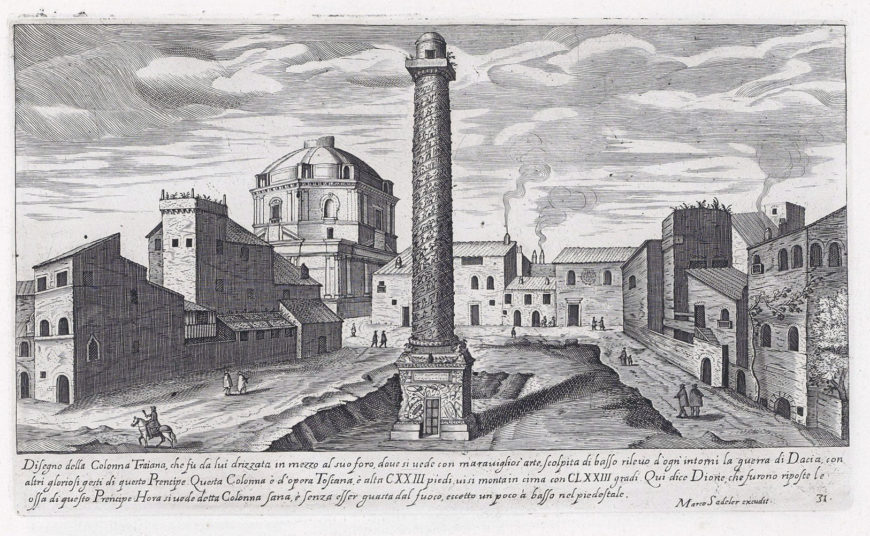
Vestigi delle antichita di Roma, Tiuoli, Pozzuolo et altri luochi, 1680 (Hier. Ferri copy of Aegidius Sadeler II engravings of reduced copies of Du Pérac’s Vestigi dell’antichità di Roma) (Rijksmuseum, Amsterdam)
The enduring ruins, in this case cleared initially by the excavations sponsored by the Fascist regime of Benito Mussolini, stand as strong, and stark, reminders of these Roman realities. Modern viewers still extract and reinforce ideas about identity based on looking at and visiting the ruins. Even with these ruins we still come away with an idea about Trajan’s greatness and his martial accomplishments. We might, then, judge the architectural program to be a great success—so successful that a great many of our own public monuments still operate on the basis of conventions established in antiquity.
Additional resources:
Forum of Trajan, Rome Reborn (Dr. Bernard Frischer)
J. C. Anderson, Historical Topography of the Imperial Fora (Brussels: Latomus, 1984).
R. Chenault, “Statues of Senators in the Forum of Trajan and the Roman Forum in Late Antiquity,” The Journal of Roman Studies, vol. 102 (2012), pp. 103–132.
P. Gros, L’architecture romaine du début du 3e siècle av. J.-C. à la fin du Haut-Empire 1. Les monuments publics (Paris: Picard, 1996).
L. Lancaster, “Building Trajan’s Markets,” American Journal of Archaeology 102.2 (Apr., 1998), pp. 283–308.
L. Lancaster, “Building Trajan’s Markets 2: The Construction Process,” American Journal of Archaeology 104.4 (Oct., 2000), pp. 755–785.
R. Leone, et al. Fori imperiali: demolizione e scavi: fotografie, 1924–1940 (Milan: Electa, 2007).
W. L. MacDonald, The Architecture of the Roman Empire 2 vols. (New Haven : Yale University Press, 1982–1986).
R. Meneghini, L. Messa, and L. Ungaro, Il foro di Traiano (Rome: Fratelli Palombi, 1990).
R. Meneghini, Il Foro e i Mercati di Traiano: Roma (Rome: Istituto poligrafico e Zecca dello Stato, 1995).
J. E. Packer, K. L. Sarring, and R. M. Sheldon, “A New Excavation in Trajan’s Forum,” American Journal of Archaeology 87.2 (Apr., 1983), pp. 165–172.
J. E. Packer, “The West Library in the Forum of Trajan: The Architectural Problems and Some Solutions,” In Eius virtutis studiosi : classical and postclassical studies in memory of Frank Edward Brown (1908–1988) (Studies in the History of Art, Vol. 43, Symposium Papers XXII), edited by A. R. Scott and R. T. Scott, 420-444. (Washington D.C.: National Gallery of Art, 1993).
J. E. Packer, “Trajan’s Forum again: the Column and the Temple of Trajan in the master plan attributed to Apollodorus(?),” Journal of Roman Archaeology 7 (January 1994) pp 163–182.
J. E. Packer, “Report from Rome: The Imperial Fora, a Retrospective,”American Journal of Archaeology 101.2 (April 1997), pp. 307–330.
J. E. Packer, The Forum of Trajan in Rome: a study of the monuments. 2 v. (Berkeley: University of California Press, 1997).
J. E. Packer, The Forum of Trajan in Rome: a study of the monuments in brief (Berkeley: University of California Press, 2001).
J. E. Packer and J. Burge, “Templum Divi Traiani Parthici et Plotinae: a debate with R. Meneghini,” Journal of Roman Archaeology (January 2003) pp. 103–136.
Platner, S. B. and T. Ashby. 1929. “Forum Traiani.” In A Topographical Dictionary of Ancient Rome (Oxford: Clarendon Press) (Perseus Project)
L. Ungaro et al. The Museum of the Imperial Forums in Trajan’s market (Milan: Electa, 2007).
P. H. von Blanckenhagen, “The Imperial Fora,” Journal of the Society of Architectural Historians 13.4 (Dec., 1954), pp. 21–26.
A. Uggeri, Della Basilica Vlpia nel Foro traiano: istoria e ristaurazione agli amanti delle antichita romane (Rome, 1830) (viewable online via Arachne)
M. Waelkens, “From a Phrygian Quarry: The Provenance of the Statues of the Dacian Prisoners in Trajan’s Forum at Rome,” American Journal of Archaeology 89.4 (Oct., 1985) pp. 641–653.
G. Wightman, “The Imperial Fora of Rome: Some Design Considerations,” Journal of the Society of Architectural Historians 56.1 (March 1997) pp. 64–88.
Smarthistory images for teaching and learning:
[flickr_tags user_id=”82032880@N00″ tags=”TrajanMkt, Forum of Trajan Column of Trajan,”]
[0:00] [music]
Dr. Steven Zucker: [0:04] Perhaps the most powerful emperor in the history of Rome.
Dr. Beth Harris: [0:08] Well, certainly one of the most popular.
Dr. Zucker: [0:10] And one of the most successful in a military sense, was the Emperor Trajan. He built not only the largest imperial forum in Rome’s history.
Dr. Harris: [0:19] That is the biggest, most magnificent public space. In addition to temples and libraries, he also built a vast public bathhouse.
Dr. Zucker: [0:27] He also built the Markets. This was, in essence — what we would recognize in the modern world — a huge shopping complex, a kind of mall, with more than 150 offices and storefronts.
Dr. Harris: [0:38] As emperor, you could choose to build public buildings. You could build private dwellings, palaces for yourself. You could build a combination of both.
[0:46] Not long before Trajan, the Emperor Nero had appropriated vast amounts of land that belonged to the Roman people to build his palace, the Domus Aurea. The emperors that came immediately after him for the most part decided to build instead projects for the Roman public.
Dr. Zucker: [1:03] The Flavians, for example, built the amphitheater that we call the Colosseum. Trajan continues that tradition by building this massive public project, both the forum and the adjacent market.
[1:14] The market is so interesting to me because for so long when I thought of ancient Roman architecture, I thought of temples, I thought of fora, I thought of these large civic spaces. What I didn’t realize was that the Romans were extremely adept at building dense, multi-story structures, that is, basically apartment buildings, office blocks. That’s what we have here.
Dr. Harris: [1:34] They had concrete, which allowed them to really shape space in a way that you can’t do with spaces that are constructed with post-and-lintel architecture, essentially columns and roofs. For example, here in the Markets of Trajan, when we enter the central hallway, we look up and we see this very high, wide space constructed with the use of groin vaults made with brick-faced concrete.
Dr. Zucker: [1:59] A groin vault is simply a barrel vault that has been intercepted by a second barrel vault that is perpendicular to it. In this case, we have the main barrel vault of the hallway, which is quite long, intersected by additional barrel vaults at right angles. You get this X-shaped archway.
Dr. Harris: [2:17] This was done by Trajan’s chief architect, Apollodorus of Damascus, an amazing engineer and architect who also built bridges and other military structures for Trajan. Apollodorus of Damascus also built, on either side of this groin-vaulted hallway, offices that are supported by barrel vaults and linked to the main hallway by buttresses.
Dr. Zucker: [2:41] What I find so phenomenal about this space is the amount of light that is let in. This is because the Romans had become so adept at using concrete. The ability to give up weight-bearing wall for apertures, for windows to let light in, both in the vaulting and in the walls, speaks to the extraordinary level of confidence of the ancient Romans under Trajan.
Dr. Harris: [3:02] Soon after this, under the Emperor Hadrian, the Romans will build one of the most beautiful surviving monuments today, and that is the Pantheon. An enormous, uninterrupted domed space, created with the use of concrete.
Dr. Zucker: [3:15] Here in the center of Rome we have, intact, one of the most complex urban spaces dating from ancient Rome. It is a spectacular display of Roman engineering, and gives us a real window into what Roman life must have been like.
Dr. Harris: [3:29] The Romans had a nickname for Trajan, and that was “Optimus Princeps,” and that means “best leader.” Standing here, overlooking Trajan’s forum, and standing in the market that he commissioned, we can understand why they would call him that.
[3:43] [music]

